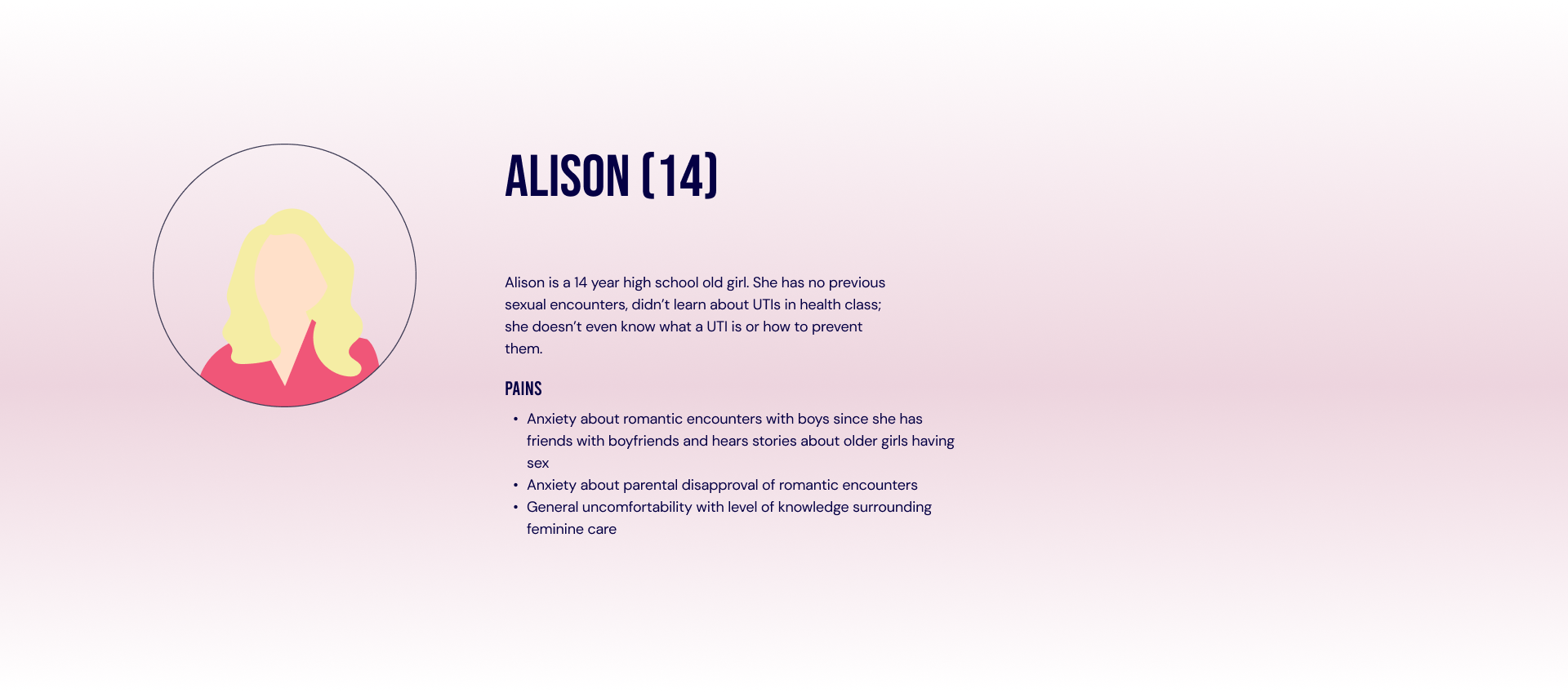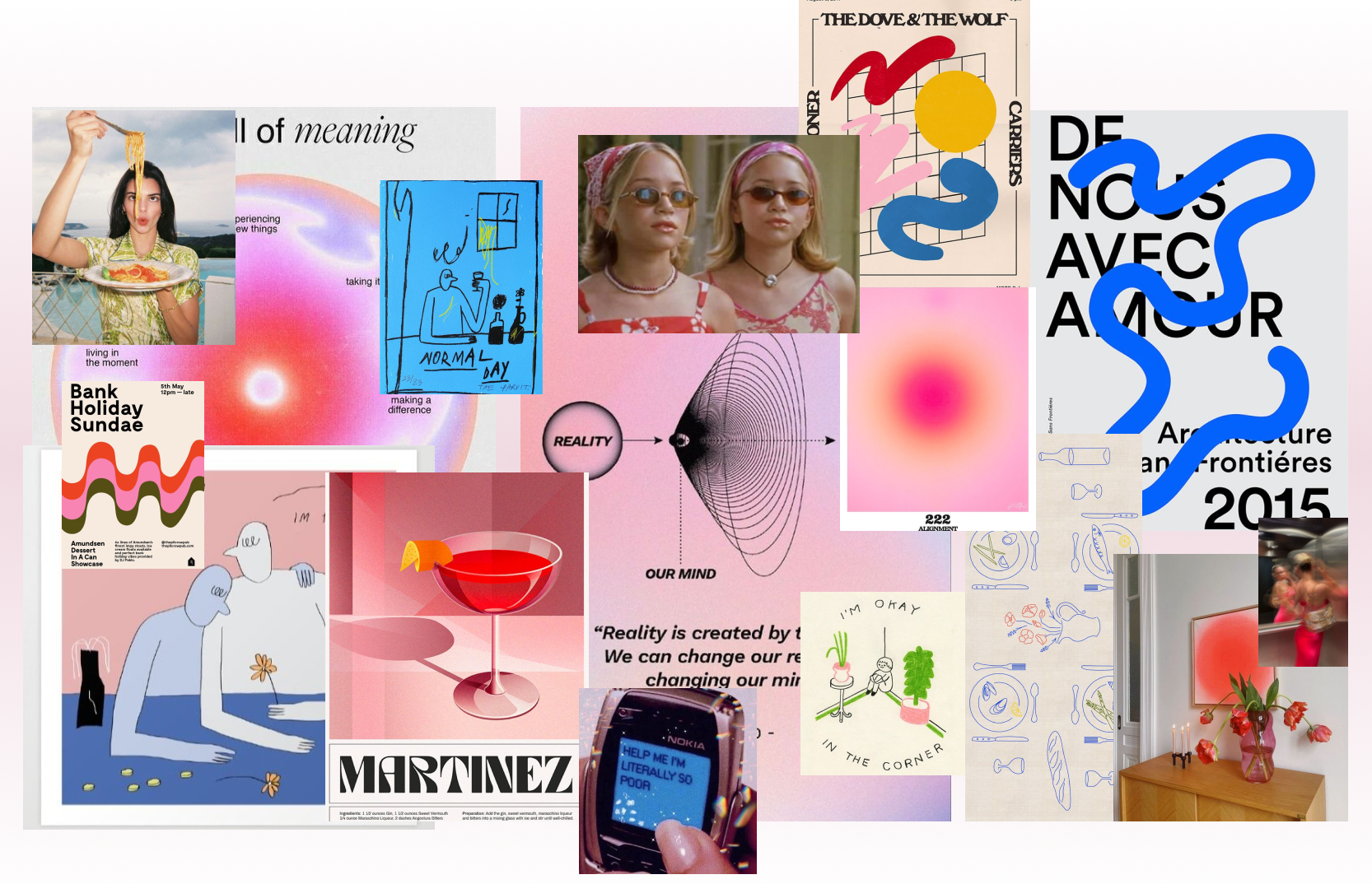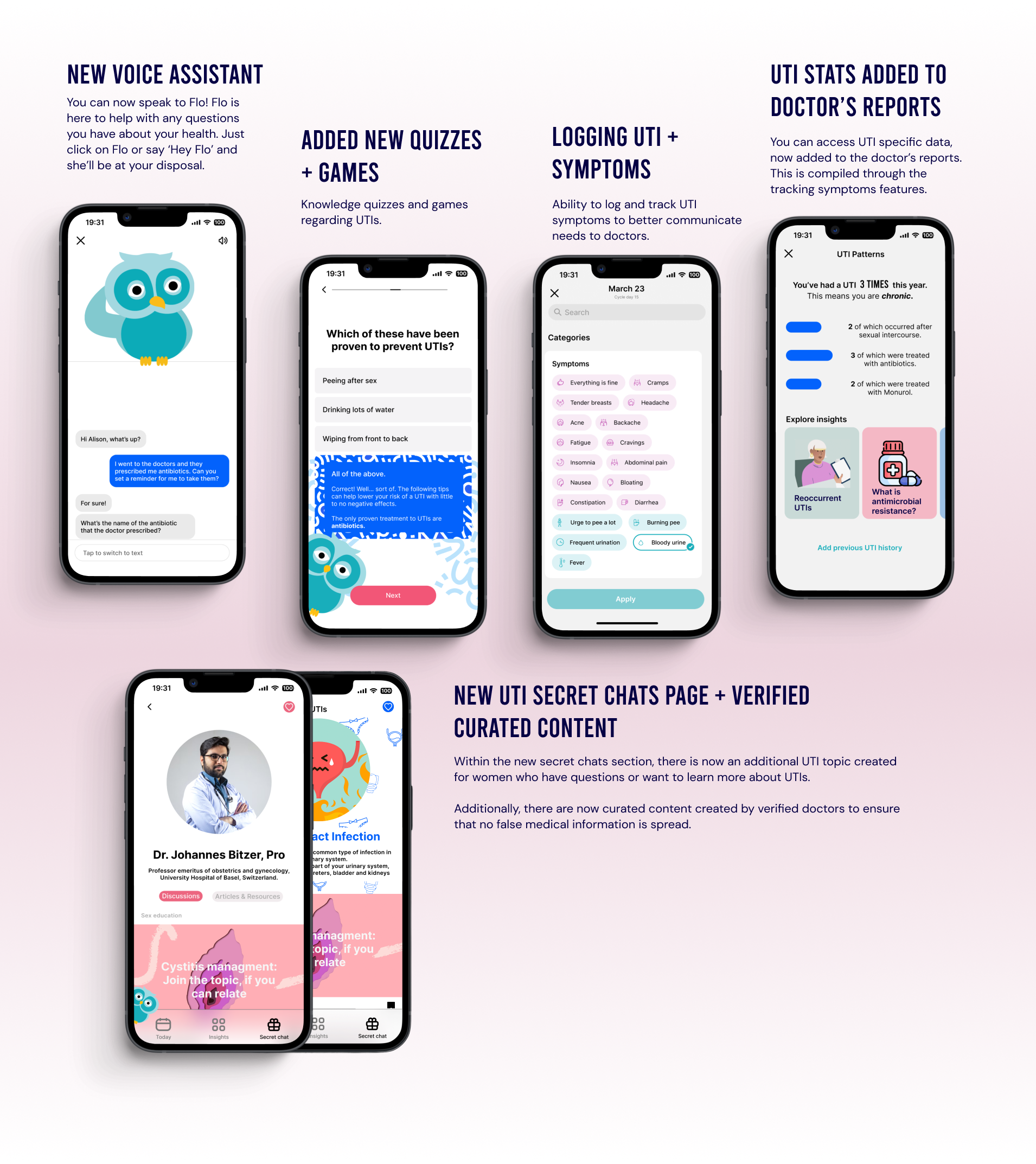Flo + UTI Expansion
[In Collaboration with: Angela Landi, Jack Laven]Role: UX/UI Designer, Conversational Designer, Researcher

Abstract
Urinary Tract Infections (UTIs) are a common problem for young women which can be both painful and frustrating. Surprisingly, many of these women lack knowledge on effectively treating UTIs. To help address this issue, we expanded the functionality of Flo, an app designed to assist women during their periods. Now, Flo encompasses comprehensive UTI information, tracking features, and educational resources, empowering young girls to proactively manage and prevent UTIs. Moreover, we have introduced a digital assistant within Flo, offering users prompt and accurate responses to any health-related inquiries they may have.

The Challenge
As part of the project brief, we were tasked with creating a digital assistant that could help educate users on intimate care, with a focus on UTIs (Urinary Tract Infection Diseases), their prevention and treatment and Antimicrobial Resistance (AMR). Our reserach aimed to address one question: “How can digital assistance improve our literacy of well-being and intimate care at home?”
Research
Desk + User Research
With our brief in mind, we began reviewing several resources to better understand the issues of Urinary Tract Infections (UTIs) and where there was potential for developing better health literacy.We then started to conduct some initial 1:1 interviews, focusing on women who had suffered from chronic UTIs and a microbiologist expert. In these interviews, we quickly shaped our topic of interest around prevention of UTIs. Specifically, we looked into alternatives for antibiotics and any other proactive or preventative methods that could be used. We quickly discovered however, that although probiotics and home remedies helped some patients, there was little research that supported their claim. From here, we needed to restructure our research— with the lack of alternative remedies, the best way we could prevent and better teach intimate care regarding UTIs was through education.
We conducted another round of desk research and interviewed 13 more women focusing on those who have experienced frequent UTIs and similar conditions, young women (aged 18-24) who have had one or less UTIs in their lifetime and healthcare professionals.

Key Findings
From our research, we developed three key insights and opportunities to help develop the problem definition. The common themes, in the insights, were awareness, research and prevention.


Define
The Problem
Young women need a way to become informed about preventing, identifying, and effectively treating UTIs before they could become a problem for them. Equally important is instilling a sense of confidence in their knowlege and abilities to manage UTIs. This led us to the reframing of our “How Might We” question.“How might we better teach intimate care in young women to better treat UTIs and manage the threat of antibiotic over-usage?“

The Target
While we would like the UTI expansion to be usable by all women, just as the base app is, we wanted to target young women in order to break the UTI loop early before it leads to chronic UTIs and over-use of antibiotics. Young women are already in the mode of learning about feminine health and are likely to be receptive to new tools and information about UTIs. Additionally, women aged 18-24 are most effected once sexually active and educating them before they get to that stage could help prevent any problems that could arise in their future.To gain deeper insights into our target audience, we diligently conducted interviews at every stage of the process, including in our ideation, user testing, and branding to ensure their perspectives and needs were at the core of our decision-making.
Ideate
The Ideation
According to Avily & Levis, “Health apps have often been conceptualized as revolutionary tools for patient empowerment and education (2019).” And in an age of digital devices, what better way to educate Gen Z than through a health application.In our ideation we found that creating an application unique to UTIs could be too niche, and from our initial research we discovered that our demographic preferred the information be embedded into their existing routines and classes. We therefore developed a UTI expansion app that would be embedded into an existing period app— an app widely used by young women to track their periods and daily symptoms.
To begin this, we started with some market research and identified some applications that we thought had potential. We initially identified six applications and rated their positives and negatives.
Benchmarking

We chose the app Flo as it showed the greatest potential for incorporating the features we wanted to fit in. We then conducted an analysis of must-haves, could-haves, should-haves and won’t haves for the application going forward.
![]()
From the analysis we dissected the opportunities of focus including:
To develop a better idea of what our target is captivated by we did some additional desk research and then created a mood-board with that information.
Some key desk research we found was:

From the analysis we dissected the opportunities of focus including:
- Creating a voice assisted animated character to give more personality to the application and to help assist the user in their problems
- Added UTI Features including sections dedicated to UTIs, games and articles to better appeal to our target.
- A free feature of the app for women under 18 to help promote health literacy.
- UTI Doctor’s Reports within the insights to help women better track their symptoms and infections and easily share with doctors.
- Added UTI Symptoms within the existing symptom tracking to put into the Doctors Reports.
Customer Journey
To better understand how our user could acquire and use the new extension pack, we developed a user journey map to better understand their experiences. These consisted of three different phases; the before, during and after which walked through Alison’s activities and emotional experiences.Validate
Visual Identity + Character Development
To develop a better idea of what our target is captivated by we did some additional desk research and then created a mood-board with that information.
Some key desk research we found was:
- Gen Z does not like distinctions like blue for boys and pinks for girls;
- Gen Z enjoys trend-led identity packs with a flexible palette of icons and colors to reflect ‘trends.’
- 2-3 colors is more than enough and make sure that content is visible.
- 3-D images and inclusive images is popular amongst Gen Z.

User Interface
From there we began to develop the branding of the UTI Expansion. The new colour palette consisted of bright and vivid colours associated with Gen Z— our target audience. Specifically, we added two bright blues and a funky patterns to appeal more to our demographic as the existing application was quite plain and lackluster. The blues and funky patterns are found within the app in sections where the new UTI features are included.For the font, we chose Inter because it is the one used by the existing app and we did not want to destabilize the user. We additionally added Bebas, a more contemporary font to help distinguish the new UTI feature.

We then developed the personality and look of our voice assistant that would be incorporated into the app, an owl named Flo. Flo was developed in Adobe Character Animator to better show her expressions and give the same expression of speaking to our user. We created four main states as shown above, each representing a different action. An owl was chosen as they are an animal characterized by wisdom and the original logo of the Flo app is a feather. After some interviews, and to accommodate to Gen Z preferences, we steered away from pink for her appearance. As a big sister, her personality is helpful but a little sassy in nature which was reflected in her natural dialogue.
Wireframing
After the branding and functionalities were determined, we began low-fidelity wireframing on existing screens and new screens using Figma. We additionally began prototyping conversations through Protopie.Onboarding

Virtual Assistant + Content

Health Reports, Stats + Test Results

Test
User testing for the voice assistant was composed of two stages: Lo-Fi Wizard of Oz testing and a Hi-Fi prototype using ProtoPie.
Lo-Fi Wizard of Oz
Before developing a working prototype we decided to use the Wizard of Oz test method to get feedback on our concept and voice flows of the voice assistant. Voice flows were tested by mapping our potential conversational flows This was refined throughout the user testing.
Signal is a chat service that had a similar interface to our mockup of the chat the user would have with Flo, so we used that for the messages and a WhatsApp phone call in the background to mimic the voice. We also used text-to-speech for the VA’s voice in order to better approximate its speech patterns.
However, because of this large pipeline of software working in tandem, the responses came with a large delay that affected the ability to use the model to test what we wanted as the users were more concentrated on the functionality of the VA than its personality.
However, because of this large pipeline of software working in tandem, the responses came with a large delay that affected the ability to use the model to test what we wanted as the users were more concentrated on the functionality of the VA than its personality.
Hi-Fi Testing
For the Hi-Fi prototype we used ProtoPie to give the interface a much more similar design to the mockup we had envisioned. It also had speech recognition paired with many responses to possible utterances which could be voiced and shown automatically by ProtoPie in response to user prompts/questions.
Outcome
Flo + UTI Expansion is the ultimate app for period tracking and intimate care. The comprehensive platform now goes beyond the norm by providing thorough UTI tracking, credible resources, and voice-activated assistance to help advise proper treatment and prevention of UTIs. With Flo + UTI Expansion, you have the power to take control of your health and well-being like never before.
Check out the full project here ︎︎︎